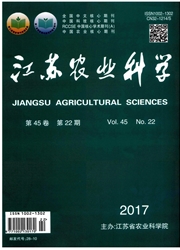

 中文摘要:
中文摘要:
Chaenomeles sinensis spot leaf cast is one of the most serious diseases in production. The biological characteristics of Marssonina coronaria were studied and the suitable pesticides against the pathogen were screened in the paper,to provide a scientific basis for studies on epidemic regularity and control of the disease.The effects of different nutrition and environmental conditions as well as nine pesticides on the mycelial growth of M. coronaria were investigated in this paper. The results indicated that the mycelium grew well on the PDA medium with p H of 7. ,and soluble starch and urea were suitable carbon and nitrogen sources,respectively. The lethal temperature was 45 ℃,and the light-dark alternation( 12 /12h) was benefit for mycelial growth. Among the nine tested pesticides,carbendazim was the most effective agent,with EC50 of 8.78 mg / L,and its relative inhibition rate was 85% under the recommended concentration of 1.0 mg/L. Mancozeb was the least effective agent,and its relative inhibition rate was only 40. 8% under the recommended concentration of 1.67 mg/L.
 英文摘要:
英文摘要:
Chaenomeles sinensis spot leaf cast is one of the most serious diseases in production. The biological characteristics of Marssonina coronaria were studied and the suitable pesticides against the pathogen were screened in the paper, to provide a scientific basis for studies on epidemic regularity and control of the disease. The effects of different nutrition and environmental conditions as well as nine pesticides on the mycelial growth of M. coronaria were investigated in this paper. The results indicated that the mycelium grew well on the PDA medium with pH of 7.0, and soluble starch and urea were suitable carbon and nitrogen sources, respec- tively. The lethal temperature was 45 ~C, and the light-dark alternation (12/12h) was benefit for mycelial growth. Among the nine tested pesticides, carbendazim was the most effective agent, with ECs0 of 8.78 mg/L, and its relative inhibition rate was 85 % under the recommended concentration of 1.0 mg/L. Mancozeb was the least effective agent, and its relative inhibition rate was only 40.8% under the recommended concentration of 1.67 mg/L.
 同期刊论文项目
同期刊论文项目
 同项目期刊论文
同项目期刊论文
 期刊信息
期刊信息
